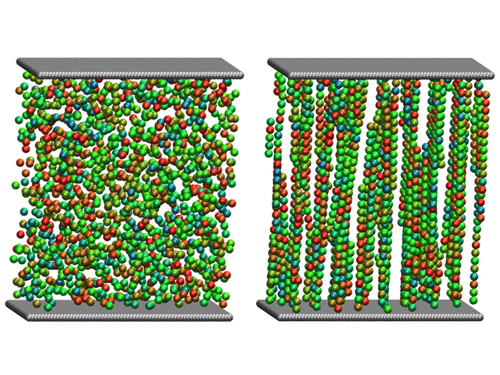Magnetorheological fluids in clutches
Introduction

Magnetorheological fluids (MRF) consist of magnetizable solid particles (mostly iron) in a carrier fluid. Upon applying an external magnetic field, the particles are magnetized and form chains along the lines of the magnetic flux (see figure). This causes the MRF to change from a liquid to a solid state within milliseconds, which makes MRFs interesting for numerous industrial applications.
The advantages of MRF include:
Fast reaction time
Low wear
Simple design (few or no moving parts)
Low sensitivity to impurities
Exact controllability of torque transfer (in clutches)
Generation of the external field with a permanent magnet where applicable – no need for electricity, which results in a high energy efficiency.
MRF applications include clutches, shock absorbers and brakes.
The SimPARTIX® simulation suite allows for a magnetorheological fluid to be modeled at particle level under in-service conditions. The simulation enables specific investigations of how the relevant parameters influence the properties of the MRF.
The task
The MRF has to meet different requirements with respect to flowability, magnetizability, etc. depending on the particular application. Within the scope of the Fraunhofer System Research for Electromobility promoted by the Federal Ministry of Education and Research the use of MRF in clutches is studied numerically. We are interested in finding out what conditions are needed to achieve a maximum torque transfer. The volume of the solid particles in the liquid, the size of the particles and the viscosity of the carrier fluid are just some of the factors that influence the behavior of the MRF. The material of the particles and the structure of the enclosing walls can also play a role.
With SimPARTIX®, a numerical model of the magnetorheological clutch was developed. The relevant parameters (particle volume fraction, walls, external magnetic field, etc.) were varied in order to investigate how they affect the torque transfer.
Results

It was found that an adequate treatment of the particle-wall interaction is crucial for the predictive power of the model. The SimPARTIX® model uses physically motivated force laws for the particle-wall interaction. With this model, the experimental shear stress behavior as a function of magnetic field, shear rate, fluid viscosity and volume fraction of particles could be reproduced.
Furthermore, the shear stress transmission is influenced by wall properties like roughness or magnetism, as well as by the coating of the suspended particles. Based on systematic numerical studies, possibilities for shear stress enhancement were proposed.
Apart from the macroscopic shear stress behavior, also the microscopic structure formation of the particles could be reproduced by the numerical model. The simulations give insight into the processes inside the clutch. Thus, a deeper understanding of the mechanisms of shear stress transmission is obtained.
 Fraunhofer Institute for Mechanics of Materials IWM
Fraunhofer Institute for Mechanics of Materials IWM